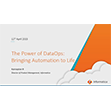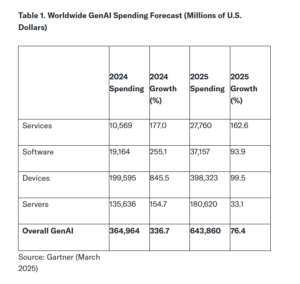
GenAI Investments Accelerating, IDC and Gartner Say

(khunkornStudio/Shutterstock)
The pace of investment and innovation in generative AI is accelerating as companies spend hundreds of billions to generate tens of trillions in business returns over the next decade, IDC and Gartner said in separate reports this week.
Gartner on Monday announced that it sees worldwide GenAI spending growing 76.4% in 2025 to reach $644 billion. About 80% of that spending is going to AI-enabled devices and servers, the analyst firm said, with about $37 billion going to software and $28 billion to services.
The race among AI model builders to develop and train bigger and better foundation models is driving much of the hardware spending. That trend will continue at least through 2026, said John-David Lovelock, a distinguished VP analyst at Gartner.
Device makers are also embedding GenAI into consumer products–whether customers are asking for them or not.
“The market’s growth trajectory is heavily influenced by the increasing prevalence of AI-enabled devices, which are expected to comprise almost the entire consumer device market by 2028,” Lovelock stated. “However, consumers are not chasing these features. As the manufacturers embed AI as a standard feature in consumer devices, consumers will be forced to purchase them.”
GenAI is having a transformative impact across all aspects of IT spending markets, Gartner said, adding that it “suggests a future where AI technologies become increasingly integral to business operations and consumer products.”
That sentiment of far-reaching AI effects jibes with a forecast released today by IDC, which said that AI will account for 3.7% of the world’s economy by 2030 and drive a cumulative impact of $22.3 trillion.
IDC says that AI investments have the benefit of a multiplier effect. For every $1 spent on AI solutions and services by adopters, IDC says it will generate an additional $4.90 in the global economy.
“AI is enhancing operational efficiency, increasing productivity, and opening new revenue streams across various sectors,” the analyst group says. “Its ability to automate routine tasks allows for the reallocation of resources to more strategic and creative endeavors.”
IDC mentioned the large investments being made in compute infrastructure to support AI training and inference, citing the Stargate project in the US, the InvestAI initiative in the EU, and France’s AI compute, among other “AI factories.”
“Continuous business innovation through the use of AI, accelerated by growing use of AI Agents, are driving greater direct investments in infrastructure and software as well as generating substantial indirect spending across the technology delivery supply chain,” stated Rick Villars, group vice president of worldwide research for IDC. “Large cloud service providers are investing heavily in infrastructure, reflecting the growing importance of complex AI ecosystems that support regional competitiveness and business expansion.”
The two analyst reports cap an enthusiastic month for GenAI, and agentic AI in particular. The growing popularity and potential of AI was on full display at Nvidia‘s GTC 2025 conference in mid-March, when CEO Jensen Huang predicted a 100x increase in inference workloads as a result of the growth of AI agents powered by a new class of reasoning models.
However, rosy predictions have a way of petering out. Sparingly few GenAI projects are making it into production, and Gartner noted last summer that 30% of GenAI projects will be abandoned this year. A number of hurdles–including access to GPUs and power, availability of new training data, stubbornly high hallucination rates, security and privacy concerns, and new regulations–remain to be cleared.
The question is: Is there enough runway for GenAI to clear these hurdles before CFOs put their collective feet down?
Related Items:
Nvidia Preps for 100x Surge in Inference Workloads, Thanks to Reasoning AI Agents
GenAI Adoption: Show Me the Numbers
Gartner Warns 30% of GenAI Initiatives Will Be Abandoned by 2025




























